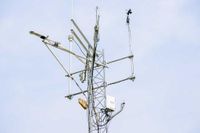On September 6, 2025, the Northeast braced for a dramatic bout of severe weather as more than 25 million people found themselves under alert for damaging thunderstorms and the threat of flash flooding. According to ABC News, a severe thunderstorm watch was issued for a massive swath of the region, stretching from Maryland all the way up to Maine, and encompassing some of the country’s busiest cities along the Interstate 95 corridor—Baltimore, Philadelphia, New York City, and Boston among them.
Throughout the afternoon and into the evening, the skies darkened and the air grew heavy. The National Weather Service warned that the primary hazards from these storms would be strong, potentially damaging wind gusts, isolated large hail, and, in some areas, even the slim chance of a brief tornado or two. For those living in northern New England, the risk of tornadoes was just enough to keep everyone on edge. And if that wasn’t enough, slow-moving thunderstorms with torrential rain threatened to trigger localized flash flooding, especially in urban and poor-drainage areas, with frequent lightning lighting up the sky.
In Connecticut, the situation escalated quickly. As reported by The Hartford Courant, scattered severe thunderstorms struck from Norwalk to Norfolk and points east, bringing with them heavy rain and damaging winds. Twin Lakes Road at Cooper Hill Road in Salisbury was closed after trees came down and blocked the road, a vivid reminder of the storm’s power. By 6 p.m., most of the severe thunderstorm watches and warnings had expired, but Tolland and Windham counties remained under a watch until 8 p.m. The line of storms had earlier lashed nearly all of Connecticut, with a swath of severe storm warnings cutting across the state from the southwest into Hartford County.
“It looks like Salisbury got the worst of the storm,” Jon Barbagallo, public information officer for Norfolk and several other first-response agencies in the Northwest Corner, told The Hartford Courant. Emergency crews were already out on an Appalachian Trail rescue when the storm hit, and they were quickly called to multiple incidents, including two vehicle crashes and a person trapped in a car with wires down on either side. Eversource crews had to walk two miles to reach a vehicle trapped by fallen wires in the Taconic section, but by the time they arrived, the driver had already been freed, either by himself or with help from emergency services.
Elsewhere in the state, the storm made its presence known in different ways. A 60-mph wind gust was recorded at the Riverside Yacht Club in Greenwich, and Berlin residents reported that the high winds were causing the rain to fall "sideways." In New Haven, torrents of rain sent water cascading along roadsides after 4 p.m., though the deluge let up less than an hour later. Cheshire firefighters were called to patch a residential roof damaged by lightning just minutes before the pounding rain began.
As the storms marched across Connecticut from west to east, they brought downpours and poor driving visibility to a wide swath, at one point stretching from Tolland to Middletown. The National Weather Service had issued severe thunderstorm watches across all of Connecticut—except New London County in the southeast—and the warnings included the potential for 60-mph winds and quarter-sized hail in Hartford and parts of Tolland counties. By early evening, the most severe warnings had expired, but the memory of the afternoon’s chaos lingered.
Massachusetts was not spared. In Holden, a possible tornado snapped and brought down numerous trees, as captured in dramatic video footage shared by local residents and reported by local news outlets. Meanwhile, Berkshire County faced its own tornado scare. According to Advance Local, a tornado warning was issued for the county, but the National Weather Service soon announced, “The storm which prompted the warning has weakened below severe limits, and no longer appears capable of producing a tornado. Therefore, the warning will be allowed to expire.” This announcement, made at 2:30 p.m., brought some relief, but not before residents were urged to seek shelter and stay vigilant.
These warnings were not issued lightly. The National Weather Service took the opportunity to remind the public of the crucial distinction between a tornado watch and a tornado warning. A tornado watch, they explained, means that conditions are favorable for tornado formation, and residents should be prepared—reviewing emergency plans, checking supplies, and locating safe rooms. A tornado warning, on the other hand, is a call to immediate action: a tornado has been spotted or detected by radar, and there is an immediate threat to life and property. The advice was clear: seek shelter in an interior room on the lowest floor of a sturdy building, away from windows, and avoid mobile homes, vehicles, or being outdoors if at all possible.
For many, these alerts brought a flurry of activity. Families were reminded to have communication plans, designate safe meeting places, and keep emergency supplies handy. The National Weather Service emphasized the importance of practicing tornado drills, securing safe rooms, and even reinforcing them if possible. They encouraged everyone to stay weather-ready by checking forecasts regularly, signing up for alerts, and knowing how their community sends warnings—whether by outdoor sirens, media, or smartphone notifications.
As the storms continued into the overnight hours, the threat of flash flooding loomed large. ABC News reported that the highest risk for flash flooding—categorized as Level 2 out of 4—stretched from Philadelphia to Bridgeport, Connecticut. Multiple rounds of heavy rain, sometimes from overlapping and training storms, were expected to produce localized to scattered areas of flash flooding, especially with the heaviest downpours or in areas already prone to flooding.
By Sunday, a welcome change was on the horizon. Cooler air was expected to sweep in behind the front, bringing a taste of fall to the Northeast for the second half of the weekend. But, in true autumn fashion, the cool air was not expected to linger long, with gradual warming forecast throughout the following week as the air mass shifted from west to east.
For residents across the Northeast, the weekend’s storms were a stark reminder of the region’s vulnerability to severe weather, even as summer faded into fall. The rapid onset of damaging winds, hail, tornado warnings, and flash flooding left thousands without power, closed roads, and prompted rescues. Yet, thanks to timely alerts, community preparedness, and the quick response of emergency crews, many were able to weather the storm safely. As the skies cleared and the cool air settled in, the Northeast could finally breathe a sigh of relief—at least until the next round of storms inevitably rolls in.






